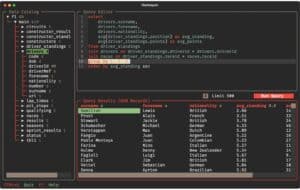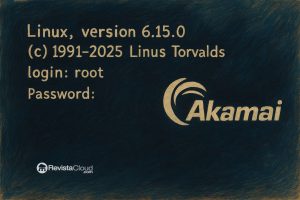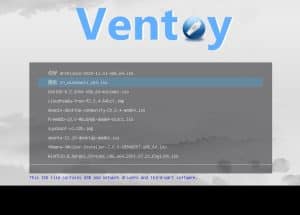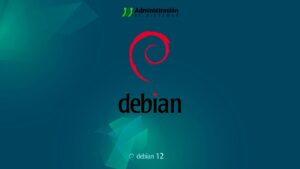Compression in in-memory databases like Redis and Valkey can be the difference between a cluster that sails through traffic spikes and one that chokes on latency, CPU, or memory. Choosing the right codec—and where to apply it—isn’t trivial: compressing “hot” cache values is not the same as compressing persistence files, and compressing JSON/HTML differs from compressing already-compressed binaries (images, ZIP, video). This article summarizes which codecs matter today (LZ4, Zstd, Gzip, Brotli, etc.), where to apply them in Redis/Valkey, and when each option pays off.
Where to compress in Redis/Valkey (and where not)
Before codecs, understand the layers where compression usually lives:
- Values (application/client-side)
- Most common in production: compress the payload (JSON, HTML, blobs) in the client before
SET/HSET, and decompress afterGET. - Pros: full control (codec & level), easy feature-flag, saves RAM and bandwidth.
- Cons: CPU in the application and extra latency if you overdo the level.
- Most common in production: compress the payload (JSON, HTML, blobs) in the client before
- Persistence (RDB/AOF)
- Redis/Valkey can compress snapshots (RDB) (historically via LZF) and you can compress AOF out of band.
- Pros: smaller disk footprint and faster backups.
- Cons: doesn’t help hot in-memory usage; mind CPU during save/load.
- Network traffic
- Typically do not compress RESP on the wire in production (TLS already adds overhead; transport-level compression rarely pays off).
- For WAN or inter-DC links, consider proxying with selective compression (large objects only).
Rule of thumb: compress in the client if the value exceeds a size threshold (e.g., > 1–2 KiB) and is highly repetitive (JSON/HTML/CSV/Protobuf), with LZ4 when latency is paramount or Zstd when you want more savings at reasonable cost.
Codec comparison table
Ratios are indicative for text-like payloads (JSON/HTML/logs). With already-compressed binaries (JPEG, MP4, ZIP), ratios drop and you often want no compression.
| Method | Estimated ratio | Practical example | Speed | Recommended scenario |
|---|---|---|---|---|
| Identity | 1× (no compression) | Binary 10 MB → 10 MB | Max | Non-compressible data, ultra-low latency |
| LZ4 | 1.10× – 1.20× | Text 10 MB → 8.5–9 MB | Extremely high | High-QPS caches (WordPress, APIs) |
| Zstd | 1.40× – 1.50× | Text 10 MB → 6.5–7 MB | Very high | Pro cache, best “space vs speed” balance |
| Gzip | 1.35× – 1.45× | Text 10 MB → 7–7.5 MB | High | Universal compatibility |
| Brotli | 1.45× – 1.60× | Web assets 10 MB → 6–7 MB | Low–medium | Web/HTTP optimization (not typical for hot RAM) |
| Bzip2 | 1.50× – 1.60× | Text 10 MB → 6.2–6.6 MB | Very low | Backups / cold storage |
| LZF | 1.10× – 1.15× | Text 10 MB → 8.7–9 MB | Extremely high | Legacy/compatibility; modest gains |
| LZMA | 1.60× – 2.0× | Text 10 MB → 5–6.5 MB | Very low | Offline files, space above all else |
| Zlib | 1.35× – 1.45× | Text 10 MB → 7–7.5 MB | High | Classic/mixed platforms |
Quick takeaways:
- LZ4 = “latency first”.
- Zstd = “modern default balance”.
- Gzip/Zlib = “universal compatibility”.
- Brotli/LZMA/Bzip2 = “max ratio, not for real-time”.
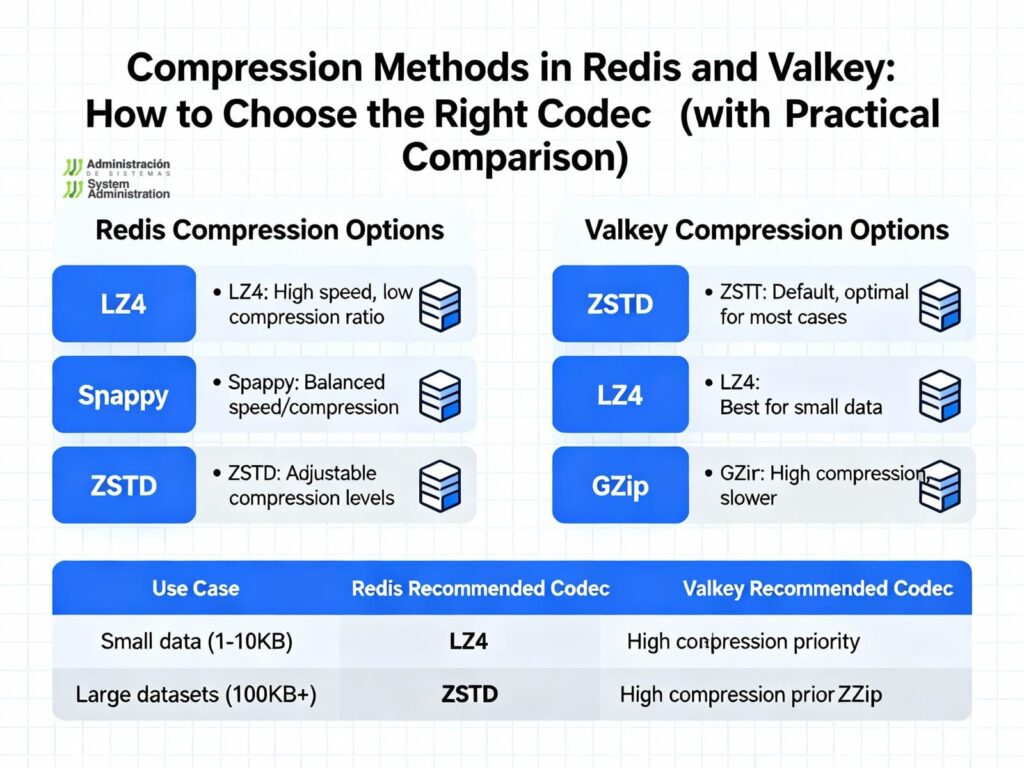
Redis vs Valkey: what really changes?
- In production, value compression is typically done client-side (middleware/SDK/proxy).
- Redis and Valkey share the ecosystem and codec availability via clients, middleware, and modules. The most common cache choices are
lz4andzstd;lzfpersists for compatibility or very tight CPU;nonesuits ultra-low latency or already-compressed data. - Valkey often exposes a broader set of compressors via integrations (e.g., django-valkey), while Redis clients show the same usual suspects. In practice, LZ4/Zstd behave equivalently on both.
Operational decision rules
- Pick a size threshold
- e.g., don’t compress values < 1 KiB; compress ≥ 2–4 KiB.
- Use Identity if the content is already compressed (detect via headers/magic bytes).
- Choose codec by objective
- Low p99/p999 → LZ4 (default level): excellent throughput and latency.
- RAM/egress savings without killing CPU → Zstd (levels 1–6; avoid 15+ except batch/offline).
- Compatibility → Gzip/Zlib.
- Cold storage/backup → Brotli/LZMA/Bzip2 (off the hot path).
- Avoid double compression
- Detect Content-Encoding / magic bytes (GZIP header, ZIP EOCD, JPEG SOI).
- Observability is mandatory
- Track ratio, (de)compression time, Redis RTT p95/p99, and CPU.
- If p99 rises, lower Zstd level or switch to LZ4.
Integration examples
Python (Redis/Valkey) with Zstandard & threshold
import redis
import zstandard as zstd
r = redis.Redis(host="localhost", port=6379)
ZSTD_LEVEL = 3
THRESHOLD = 2048 # 2 KiB
cctx = zstd.ZstdCompressor(level=ZSTD_LEVEL)
dctx = zstd.ZstdDecompressor()
def kv_set(key: str, data: bytes):
if len(data) >= THRESHOLD:
compressed = cctx.compress(data)
r.set(key, b"\x28ZSTD\x29" + compressed) # tiny header marker
else:
r.set(key, data)
def kv_get(key: str) -> bytes | None:
val = r.get(key)
if not val:
return None
if val.startswith(b"\x28ZSTD\x29"):
return dctx.decompress(val[len(b"\x28ZSTD\x29"):])
return val
Code language: PHP (php)Node.js with LZ4 (latency-critical)
const Redis = require("ioredis");
const lz4 = require("lz4");
const r = new Redis();
const THRESHOLD = 2048;
const MAGIC = Buffer.from([0x28, 0x4c, 0x5a, 0x34, 0x29]); // (LZ4)
function setLZ4(key, buf) {
if (buf.length < THRESHOLD) return r.setBuffer(key, buf);
const max = lz4.encodeBound(buf.length);
const out = Buffer.allocUnsafe(MAGIC.length + max);
MAGIC.copy(out, 0);
const n = lz4.encodeBlock(buf, out, MAGIC.length);
return r.setBuffer(key, out.subarray(0, MAGIC.length + n));
}
async function getLZ4(key) {
const val = await r.getBuffer(key);
if (!val) return null;
if (val.subarray(0, MAGIC.length).equals(MAGIC)) {
const src = val.subarray(MAGIC.length);
// Prefer using LZ4 frames in production to include original size + CRC
}
return val;
}
Code language: JavaScript (javascript)Django-Valkey (configuring a compressor)
VALKEY = {
"BACKENDS": {
"default": {
"HOST": "127.0.0.1",
"PORT": 6379,
"DB": 0,
"COMPRESSION": {
"ALGORITHM": "zstd", # "lz4", "zstd", "gzip", "none", ...
"LEVEL": 3,
"THRESHOLD": 2048, # bytes
"HEADER": True # mark format/version
}
}
}
}
Code language: PHP (php)Micro-bench: how to evaluate in your environment
- Build representative datasets:
- JSON (1–50 KiB), HTML, logs, non-compressible binary blobs, and a real traffic mix.
- Measure per codec and level:
- Ratio (bytes_in/bytes_out), t_comp / t_decomp, Redis RTT p50/p95/p99, CPU (app/host).
- Try THRESHOLD = {1 KiB, 2 KiB, 4 KiB} and QPS bursts (read-heavy 80–95% typical for caches).
- Compare LZ4 (default) and Zstd (levels 1–6).
- If p99 rises >10–15% vs Identity, lower level or switch to LZ4.
- If RAM is the bottleneck, raise Zstd to 3–5 and validate CPU.
Common scenarios (what to pick)
- WordPress/HTML/API caches with high QPS → LZ4 (or Zstd-1 if p99 allows).
- JSON/Protobuf catalogs with long TTLs → Zstd-3/4 (save RAM and egress).
- Events/logs in lists/streams → LZ4 (mass ingest, low latency).
- Backups/snapshots (RDB/AOF out of the hot path) → Brotli/LZMA/Bzip2.
- Already-compressed binaries (images, ZIP) → Identity (don’t compress).
Anti-patterns & gotchas
- Over-compression: high Zstd/LZMA levels ↑CPU and ↑p99 with tiny byte gains.
- Small-key overhead: for < 1 KiB values, header + CPU usually loses.
- Double compression: detect and skip.
- Fragmentation: very large objects (> 512 KiB) can pressure the allocator; consider chunking.
- Pipelines: compress at the edge (API) but not in internal jobs if the payload is already compressed.
Final recommendations
- Modern default: Zstd-3 with 2–4 KiB threshold and a feature flag to fall back to LZ4 if p99 rises.
- Extreme latency: LZ4 frames, avoid exotic levels.
- Compatibility: Gzip/Zlib where the ecosystem requires it.
- Persistence: compress RDB/backups; keep AOF simple for minimal replay overhead.
Sources (recommended reading)
- https://www.dragonflydb.io/blog/redis-8-0-vs-valkey-8-1-a-technical-comparison
- https://www.dragonflydb.io/guides/valkey-vs-redis
- https://www.logicmonitor.com/blog/redis-compression-benchmarking
- https://dev.to/konstantinas_mamonas/which-compression-saves-the-most-storage-gzip-snappy-lz4-zstd-1898
- https://facebook.github.io/zstd/
- https://linuxreviews.org/Comparison_of_Compression_Algorithms
- https://quixdb.github.io/squash-benchmark/
- https://stephane.lesimple.fr/blog/lzop-vs-compress-vs-gzip-vs-bzip2-vs-lzma-vs-lzma2xz-benchmark-reloaded/
- https://cran.r-project.org/web/packages/brotli/vignettes/brotli-2015-09-22.pdf
- https://onidel.com/redis-valkey-keydb-vps-2025/
- https://django-valkey.readthedocs.io/en/latest/configure/advanced_configurations/
- https://experienceleague.adobe.com/en/docs/commerce-operations/implementation-playbook/best-practices/planning/valkey-service-configuration

